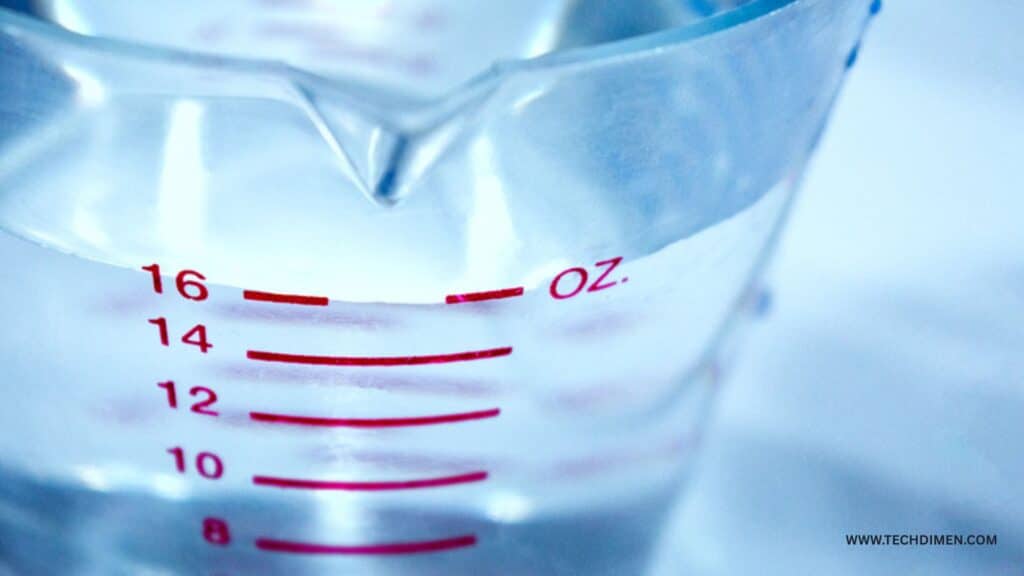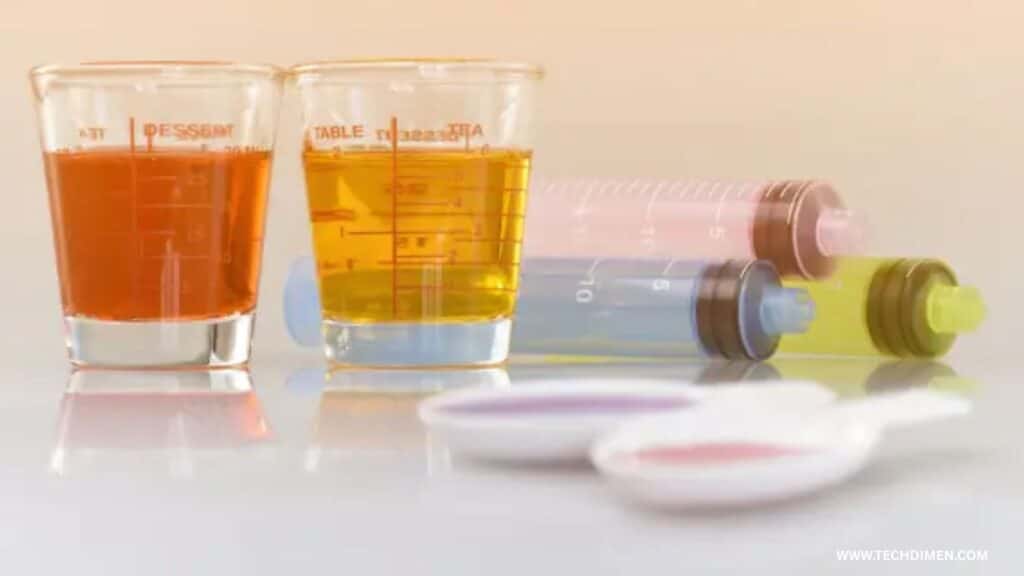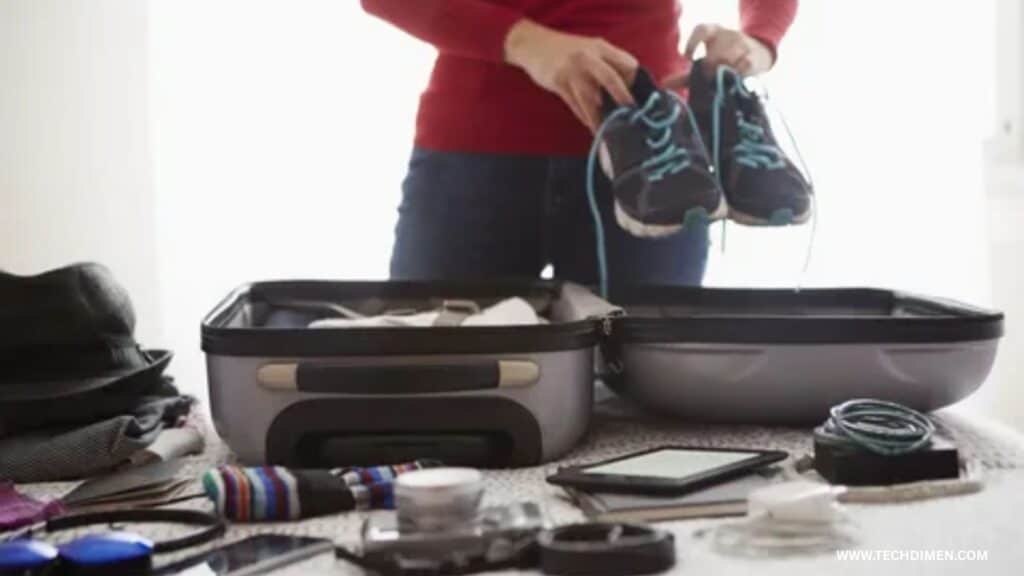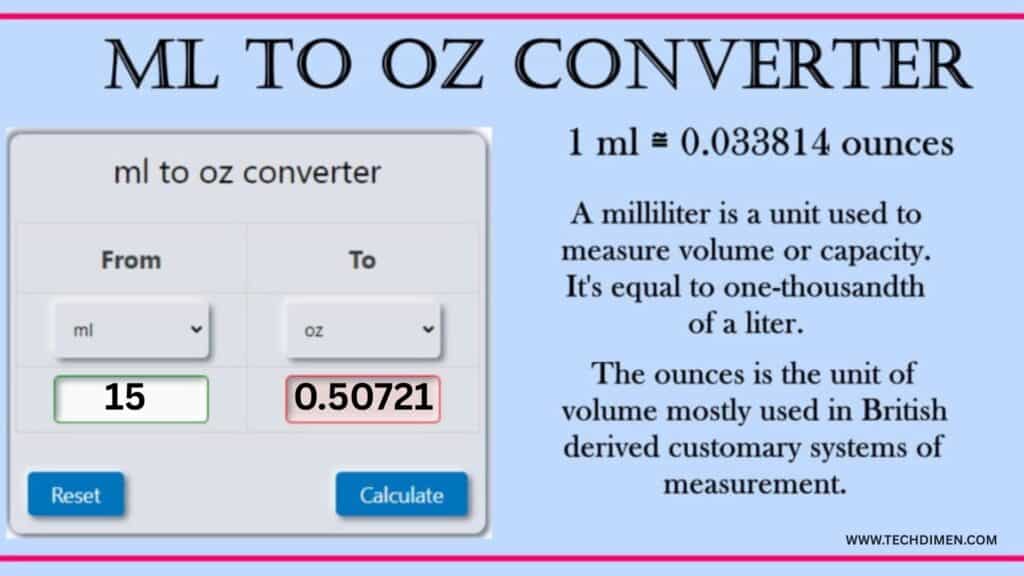When you’re working in the kitchen, pharmacy, or even a science lab, accurate measurements are crucial. Converting between milliliters (ml) and ounces (oz) can often be a point of confusion, especially if you aren’t familiar with the exact conversion factors. This guide will provide you with everything you need to know about converting 15 ml to oz, how to do it correctly, and why this conversion matters in real-life scenarios.
What Is 15 ml in Ounces

When you’re faced with converting milliliters (ml) to ounces (oz), understanding the precise relationship between these two units of measurement is important. Whether you’re cooking, handling medications, or working in a scientific context, converting accurately ensures you achieve the correct results. In this article, we’ll explore how to convert 15 ml to oz, why this conversion matters, and how it applies in real-world scenarios.
Conversion Formula: How to Convert 15 ml to Ounces
To convert milliliters to ounces, you can use the following formula:
1 ml = 0.033814 oz
So, to find out how many ounces are in 15 ml, multiply 15 by the conversion factor:
15 ml × 0.033814 = 0.50721 oz
Therefore, 15 ml ≈ 0.51 oz (rounded to two decimal places).
Why Is 15 ml Equal to 0.51 oz (and Not 0.5 oz)?
It’s easy to round 15 ml to 0.5 oz for simplicity, but the precise conversion is 0.51 oz. While this difference might seem minor, it’s important in fields like medicine, science, and precise cooking. In situations where accuracy matters such as when preparing a medication dosage or a chemical solution every fraction of an ounce can make a difference.
Practical Applications of 15 ml to oz Conversion
1. Cooking and Recipes
In the kitchen, especially when following U.S. recipes, many ingredients are measured in ounces rather than milliliters. For example, a recipe might call for 15 ml of olive oil or 15 ml of lemon juice. Converting 15 ml to 0.51 oz ensures that you’re adding the exact amount of the ingredient, which is crucial for flavor balance and recipe accuracy.
2. Medicine and Health

In healthcare, liquid dosages are often prescribed in milliliters, but they can be understood in ounces in some places, particularly in the United States. For example, a doctor may recommend a 15 ml dose of medication, which you’ll need to know how to convert to ounces for accurate measurement. Knowing that 15 ml = 0.51 oz helps avoid errors in medical dosing, ensuring safety and effectiveness.
3. Scientific and Laboratory Work
In fields like chemistry, biology, and pharmacology, accurate measurements are critical. A mistake in measuring liquids, even one as small as a few milliliters, can alter the results of an experiment or process. Converting 15 ml to 0.51 oz ensures that you’re working with the correct volume, avoiding discrepancies in experiments, formulations, and tests.
15 ml to oz: Quick Conversion Chart
For your convenience, here’s a chart showing other common conversions from milliliters to ounces:
| Milliliters (ml) | Ounces (oz) |
|---|---|
| 1 ml | 0.033814 oz |
| 5 ml | 0.16907 oz |
| 10 ml | 0.33814 oz |
| 15 ml | 0.50721 oz |
| 30 ml | 1.01442 oz |
| 50 ml | 1.6907 oz |
| 100 ml | 3.3814 oz |
What’s the Difference Between Fluid Ounces and Ounces by Weight?
When working with liquid measurements, fluid ounces (fl oz) measure volume, while ounces (oz) by weight measure mass. When converting liquids, make sure to use fluid ounces, which are specifically designed for volume.
Tips and Tools for Easy Conversion
Use Online Converters
If you don’t want to manually convert 15 ml to oz every time, there are many online conversion tools and apps available. Simply input the value in milliliters, and the tool will instantly give you the equivalent in ounces.
Keep a Conversion Chart Handy
For regular use, especially if you often work with liquids in recipes or medicine, having a conversion chart for ml to oz can be extremely helpful for quick reference.
Why is the 15 ml to oz Conversion Important?
Cooking and Recipes

For home cooks and professional chefs alike, understanding how to convert 15 ml to fluid ounces is key to following recipes accurately. Many recipes, especially in the U.S., call for ingredients to be measured in ounces. When you see an ingredient listed as 15 ml, converting it to ounces ensures you’re using the right amount of each ingredient.
For example, if a recipe asks for 15 ml of vanilla extract, and you only have a measuring cup with ounces, knowing that 15 ml is equal to approximately 0.51 oz allows you to proceed with the recipe without confusion. Whether it’s for a dessert or a savory dish, correct ingredient measurements help guarantee the success of your culinary efforts.
Medical and Pharmaceutical Dosages
Accurate dosing of medicine is crucial, particularly when it comes to liquid medications. In medical and pharmaceutical contexts, you may often encounter dosages in milliliters (ml) or fluid ounces (oz). For example, a prescription might indicate 15 ml of cough syrup. Knowing that 15 ml equals 0.51 oz is essential for taking the correct dose, ensuring that you’re not under- or over-medicated.
Pharmacies and healthcare providers frequently use this conversion to ensure accurate dispensing of medications. Whether it’s a syrup, a topical solution, or any other liquid form of medicine, precise measurements help prevent errors in treatment.
Science and Laboratory Measurements
In scientific research, experiments often require exact measurements of liquids. Whether you’re mixing solutions in a chemistry lab or measuring biological samples in a research setting, the conversion between milliliters and ounces can be critical. Understanding the exact equivalence between 15 ml and 0.51 oz can ensure that your experiments yield accurate and reliable results.
Converting 15 ml to Oz: Real-Life Applications
Converting 15 milliliters (ml) to ounces (oz) is a common task in many aspects of daily life. Whether you’re cooking, measuring medication, or conducting scientific experiments, understanding how to make this conversion accurately is essential. In this guide, we’ll explore real-life applications of the 15 ml to oz conversion, showing how this simple conversion can impact a wide range of activities.
1. Cooking and Baking: Precision in Recipes
In the kitchen, accuracy is key to creating successful dishes. Many U.S. recipes measure ingredients in ounces, making it necessary to convert milliliters into fluid ounces.
Example: Converting Liquid Ingredients
Imagine you’re following a recipe that calls for 15 ml of vanilla extract, which is a common ingredient in many desserts. Since recipes in the U.S. typically use fluid ounces, you’ll need to convert 15 ml to ounces:
15 ml × 0.033814 = 0.50721 oz
So, 15 ml of vanilla extract is approximately 0.51 oz.
This may seem like a small difference, but in baking, even small amounts of ingredients can affect the outcome, especially in delicate recipes like cakes, pastries, or sauces. Accurate measurements ensure your dish turns out just as intended.
Example: Converting Dry vs. Wet Ingredients
It’s also important to note that 15 ml of liquid (like oil or milk) is easier to convert to ounces than dry ingredients (like flour or sugar). For liquids, the conversion is straightforward using the 1 ml = 0.033814 oz factor. For dry ingredients, the conversion varies based on the ingredient’s density.
2. Medicine: Accurate Dosing
In medicine, precise dosing is vital, and understanding the conversion between milliliters (ml) and ounces (oz) ensures that patients receive the correct amount of medication.
Example: Liquid Medications

Imagine a prescription that instructs you to take 15 ml of cough syrup. If the instructions also provide dosing information in ounces, you need to convert 15 ml to ounces to ensure proper dosing.
Using the conversion factor:
15 ml × 0.033814 = 0.50721 oz
Therefore, 15 ml of cough syrup equals approximately 0.51 oz. Understanding this conversion helps prevent errors, especially when you have multiple medications with varying units of measurement.
Example: Pediatric Medicine
For children’s medicine, dosages are often provided in milliliters, but understanding that 15 ml ≈ 0.51 oz is important when using devices that measure in fluid ounces. For instance, some syringes or cups used for administering medication may use ounces as the unit of measure, and knowing the equivalent in ounces ensures accurate dosing.
3. Science and Laboratories: Ensuring Precision
In scientific research, small changes in measurement can lead to significant differences in results. Converting 15 ml to oz is essential when working with liquids in a lab, whether you’re performing experiments in chemistry, biology, or pharmacology.
Example: Preparing Solutions in the Lab
In a laboratory, you might need to prepare a solution using a liquid volume of 15 ml. Depending on your location, you may use different units of measurement milliliters in many countries or ounces in others. Converting 15 ml to ounces can help you measure your reagents accurately, particularly if your lab equipment is calibrated in fluid ounces.
Example: Measuring Reagents and Chemicals
When measuring small amounts of chemicals, even a small discrepancy in volume can drastically affect the experiment’s outcome. For instance, if your procedure calls for 15 ml of solvent and you’re using a piece of lab equipment calibrated in ounces, you’ll need to convert to ensure you’re using the correct volume. This ensures accuracy in your results.
4. Everyday Life: Quick Conversions for Convenience
Beyond cooking, medicine, and science, the 15 ml to oz conversion can be useful in various everyday scenarios.
Example: Measuring Personal Care Products
When you buy personal care products like shampoos, conditioners, or lotions, the packaging often lists the amount in milliliters. If you’re traveling or need to pack a small quantity, you may need to convert 15 ml to ounces to fit the allowed liquid limits, such as in your carry-on luggage for air travel, where liquid containers are often limited to 3.4 oz (100 ml).
5. Travel and Packaging: Small-Scale Conversions

For travel or product packaging, understanding 15 ml to oz conversion can help you manage and package your liquids efficiently.
Example: Travel-sized Products
If you’re packing 15 ml of sunscreen or perfume for a trip, you may need to know how this converts to ounces to ensure your containers comply with airport regulations. With 15 ml ≈ 0.51 oz, you can easily determine whether the liquid falls under the permissible 3.4 oz limit for carry-on items.
Quick Reference for Converting 15 ml to Oz
For quick reference, remember the following conversion formula:
1 ml = 0.033814 oz
Therefore:
- 15 ml = 0.51 oz
By knowing this conversion, you’ll be able to handle tasks in cooking, medicine, science, and everyday life with accuracy and confidence.
Quick Tips for Easy Conversions
Use a Conversion Calculator
Online tools or apps can quickly convert ml to oz with minimal effort. These calculators can be particularly useful when you need to convert various liquid volumes in real-time, such as during cooking or preparing medications.
Keep a Conversion Chart Handy
For regular use, keep a ml to oz conversion chart in your kitchen or workspace. This chart will help you quickly convert milliliters to ounces without having to perform the calculation each time. Here’s an example of a simple conversion chart for reference:
| Milliliters (ml) | Ounces (oz) |
|---|---|
| 1 ml | 0.033814 oz |
| 5 ml | 0.16907 oz |
| 10 ml | 0.33814 oz |
| 15 ml | 0.50721 oz |
| 30 ml | 1.01442 oz |
| 50 ml | 1.6907 oz |
Use Measuring Cups with Both ml and oz
If you often need to convert 15 ml to oz or vice versa, consider investing in measuring cups that include both milliliter and ounce markings. These measuring tools are widely available and make conversion easier, especially in cooking and medication measurements.
How to Convert 15 ml to Oz for Specific Purposes
For Cooking
When converting 15 ml to oz for a recipe, it’s helpful to know that many kitchen measurements are in fluid ounces, so being able to switch between the two systems is crucial. For example, if you’re baking a cake that calls for 15 ml of vanilla extract, converting it to 0.51 oz lets you follow the recipe accurately.
For Medicine
In a medical context, precise dosing is critical. Many prescription medications come in liquid form, and healthcare professionals often provide the dosage in milliliters. For 15 ml of cough syrup, knowing that 15 ml = 0.51 oz helps you administer the correct amount.
For Scientific Measurements
In the laboratory, precise measurements of liquids are essential for conducting experiments accurately. Whether you’re mixing a solution or preparing a sample, converting milliliters to ounces ensures you’re using the correct volume, which can be critical for the results of your experiment.
FAQs; About 15 ml to oz Conversion
1. What is 15 ml in ounces?
15 milliliters (ml) is approximately 0.51 fluid ounces (oz). To convert, you multiply 15 ml by 0.033814, which gives you the result of 0.50721 oz.
2. How do I convert 15 ml to ounces?
To convert 15 ml to ounces, you use the formula:
- 1 ml = 0.033814 oz
- 15 ml × 0.033814 = 0.50721 oz
Thus, 15 ml ≈ 0.51 oz.
3. Can I round 15 ml to 0.5 oz?
While it’s common to round 15 ml to 0.5 oz for simplicity, the precise conversion is 0.51 oz. Depending on the context such as in scientific or medical applications accuracy may be important.
4. How many ounces are in 30 ml?
To convert 30 ml to ounces, use the same conversion factor:
- 30 ml × 0.033814 = 1.01442 oz Thus, 30 ml ≈ 1.01 oz.
5. How many milliliters are in 1 ounce?
The reverse conversion is important too. Since 1 oz = 29.5735 ml, you can convert ounces back to milliliters using this conversion factor.
6. Can I use a 1:1 conversion for ml to oz?
No, the conversion factor between milliliters (ml) and ounces (oz) is not 1:1. Always use the factor 1 ml = 0.033814 oz for accuracy when converting between these two units.
7. What’s the difference between fluid ounces and ounces by weight?
Fluid ounces (fl oz) are used for measuring liquids, while ounces by weight are used for measuring the mass of solid materials. The conversion between milliliters and ounces applies only to liquid volume (fluid ounces).
8. What is the easiest way to convert ml to oz?
The easiest way to convert ml to oz is to use an online calculator or a conversion app. These tools allow for quick, accurate conversions without needing to manually multiply the numbers. Alternatively, you can use a conversion chart to keep the values handy.
9. Why do I need to know the conversion for 15 ml to oz?
Knowing how to convert 15 ml to ounces is useful in a variety of situations:
- Cooking: Recipes often list ingredients in ounces, and many ingredients are measured in milliliters in other countries.
- Medicine: Prescription doses for liquid medications are often given in milliliters or ounces.
- Science: Accurate measurements are crucial in laboratory work and experiments.
10. What tools can I use for quick ml to oz conversions?
For quick conversions, you can use:
- Online converters: Websites and apps dedicated to converting units like milliliters to ounces.
- Mobile apps: Many apps include unit conversion tools for easy use on the go.
- Conversion charts: Printed or digital charts are helpful for regular use, especially in professional environments.
Summary: Mastering 15 ml to oz Conversion
Converting 15 ml to oz is a simple yet essential skill that plays a significant role in many areas of life, from cooking to medicine and science. Here’s a quick recap of what we’ve covered:
15 ml = 0.51 oz (rounded to two decimal places)
1 ml = 0.033814 oz is the key conversion factor.
This conversion is crucial in cooking, pharmaceuticals, and science, ensuring you get accurate measurements every time.
Armed with this knowledge, you’ll be able to confidently convert milliliters to ounces and ensure precision in all your tasks. Whether you’re following a recipe, measuring medication, or conducting scientific experiments, this guide will serve as a reliable resource.
By mastering these conversions, you ensure that you’re always working with accurate measurements, which can make a big difference in your results, whether it’s in the kitchen, at the pharmacy, or in the lab.

Jhon AJS is a tech enthusiast and author at Tech Dimen, where he explores the latest trends in technology and TV dimensions. With a passion for simplifying complex topics, Jhon aims to make tech accessible and engaging for readers of all levels.







